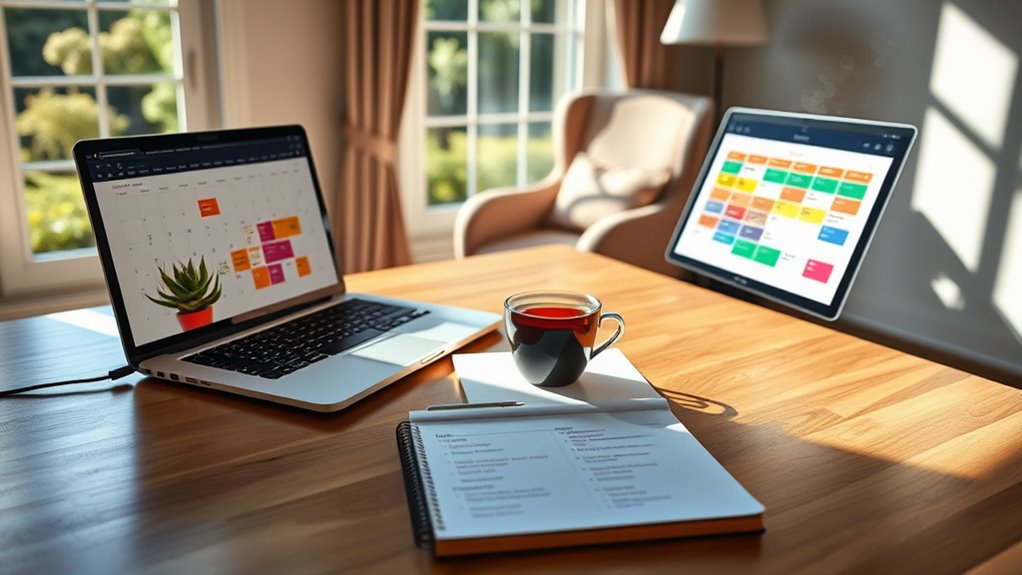Top 7 Time Management Tips for a Stress-Free Day!
Want a stress-free day? Start by setting clear, achievable goals that guide your tasks. Prioritize what truly matters and break tasks into manageable steps. Use a planner to track your progress and keep daily focus. Limit distractions by creating a clutter-free workspace and scheduling breaks for productivity bursts. Remember to reflect on your day regularly. Assess what worked and adjust accordingly for continuous improvement. With these seven tips, you’ll gain control and confidence over your time. Keep exploring to uncover more techniques for mastering your day!
Key Takeaways
- Set clear, specific goals using the SMART criteria to guide your daily tasks and maintain focus.
- Prioritize tasks by urgency and importance, using a ranking system to tackle what matters most first.
- Break larger tasks into manageable steps, assigning realistic deadlines to avoid overwhelm and enhance time management.
- Utilize a planner to track daily priorities and conduct weekly reviews to assess progress and adjust strategies effectively.
- Implement the Pomodoro Technique, working in focused sprints followed by breaks to boost concentration and productivity throughout the day.
Set Clear Goals
Setting clear goals is crucial for effective time management. When you engage in goal setting, you create a roadmap that guides your activities and decisions. Start by defining your overarching vision, then break it down into measurable objectives. This approach not only gives you clarity but also helps you track your progress.
To set effective goals, ensure they’re SMART—Specific, Measurable, Achievable, Relevant, and Time-bound. For instance, instead of saying, “I want to improve my skills,” specify, “I’ll complete a coding course by the end of the month.” This level of detail allows you to envision your success and stay committed.
Regularly review your goals and adjust them as needed. Life changes, and so should your objectives. Keeping your goals flexible yet focused ensures you remain motivated and on track. Celebrate small wins along the way; they’ll fuel your drive and reinforce your commitment to your larger vision.
Prioritize Your Tasks
To manage your time effectively, start by identifying your urgent tasks that need immediate attention. A simple ranking system can help you sort through what’s most important and what can wait. Focus on these priorities, and you’ll find you accomplish more with less stress.
Identify Urgent Tasks
Urgent tasks can often feel like a whirlwind, pulling your attention in multiple directions. To regain control, you need to master urgent task identification. Start by evaluating your to-do list and pinpoint tasks that demand immediate attention. Consider deadlines, potential consequences, and the resources involved.
Effective urgency assessment means looking beyond the surface. Not every task that seems urgent truly is; some may just provoke anxiety. Ask yourself: What will happen if I don’t complete this task today? This question helps filter out noise and focus on what genuinely matters.
Next, categorize your tasks into clear groups: truly urgent, important but not urgent, and those that can wait. This method streamlines your focus and lets you tackle what’s critical first.
Use a Ranking System
When you prioritize your tasks with a ranking system, you take control of your time and energy. This method helps you focus on what truly matters, allowing you to achieve more with less stress. Start by categorizing your tasks based on urgency and importance.
You can use a simple ranking table to visualize your priorities:
| Task | Priority Level |
|---|---|
| Complete Project A | High |
| Respond to Emails | Medium |
| Prepare Presentation | High |
| Grocery Shopping | Low |
| Schedule Doctor’s App | Medium |
Once you’ve ranked your tasks, implement time blocking for high-priority items. This means setting aside dedicated periods to tackle specific tasks without interruptions. For lower-priority tasks, consider task batching, grouping similar tasks together to maximize efficiency.
Use a Planner
Using a planner can be a game-changer for your time management. Whether you prefer a digital app or a classic paper version, it helps you set daily and weekly goals with clarity. Get started today, and watch your productivity soar!
Digital vs. Paper Planners
Choosing between digital and paper planners can feel overwhelming, but it doesn’t have to be. Both options offer unique benefits that can enhance your planner effectiveness and boost your productivity. Start by considering your personal preferences. If you thrive on digital organization, a digital planner might be your best bet. With features like reminders, syncing across devices, and easy editing, it keeps your schedule accessible and flexible.
On the other hand, if you find joy in writing things down, a paper planner might suit you better. The tactile experience of pen on paper can enhance memory retention and provide a satisfying way to track your progress. Plus, many people appreciate the absence of screens, which can reduce distractions.
Ultimately, the choice boils down to what resonates with you and your habits. Experiment with both formats if you can. Assess how each one fits into your daily routine and supports your goals. Mastering your time management starts with the right tools. Whichever planner you choose, commit to using it consistently—this is key to unlocking your full potential and maintaining a stress-free day.
Daily and Weekly Goals
Setting daily and weekly goals is a powerful way to keep your productivity on track. By implementing effective goal setting, you create a clear roadmap for what you want to accomplish. Start each day by outlining your top three priorities. This focused approach helps you tackle tasks that truly matter, ensuring you stay aligned with your larger objectives.
On a weekly basis, conduct reviews of your progress. Reflect on what you achieved, what fell short, and how you can improve. This step is crucial; it helps you adjust your strategies and keeps you accountable. Use a planner to jot down your reflections, making it easier to visualize your path forward.
Incorporate both short-term and long-term goals in your planning process. This balance fosters motivation and keeps you engaged. Remember, it’s not just about checking off tasks; it’s about making meaningful progress toward your aspirations.
Stay committed to this practice, and watch your productivity soar. By mastering daily and weekly goal setting, you’ll transform your approach to time management, reducing stress and enhancing your overall effectiveness.
Break Tasks Into Steps
When you face a big project, it can feel overwhelming, but breaking tasks into smaller steps makes it manageable. By utilizing a stepwise approach and focusing on task segmentation, you’ll find clarity and direction. Here’s how to effectively break down your tasks:
- Identify the end goal: Know exactly what you want to achieve.
- List all components: Write down every part of the project.
- Prioritize steps: Determine the order in which tasks should be completed.
- Set deadlines: Assign realistic timelines to each step.
Limit Distractions
Once you’ve broken tasks into manageable steps, the next challenge is keeping your focus sharp. To do this, you need to limit distractions. Start by creating a focused environment. Clear your workspace of clutter and organize your materials so everything you need is within reach.
Next, consider a digital detox. Disconnect from unnecessary notifications on your phone and computer. Set specific times to check emails or social media, rather than allowing them to interrupt your flow. This simple shift can dramatically enhance your productivity.
Use tools like website blockers or focus apps to eliminate online distractions. When you know you won’t be tempted to scroll through social media or get lost in endless browsing, you’ll stay on task longer.
Finally, communicate your focus time to those around you. Let them know you’re working so they can help minimize interruptions. By creating a focused environment and committing to a digital detox, you’re setting yourself up for success. Mastering your attention isn’t just about time management; it’s about creating the conditions for your best work. Stay disciplined, and watch your productivity soar!
Schedule Breaks
To maintain your momentum and prevent burnout, it’s essential to schedule regular breaks throughout your workday. By incorporating mindful pauses, you’ll not only recharge your energy but also enhance your focus and productivity. Here’s how to make the most of your breaks:
- Step away from your workspace
- Engage in a physical activity, even for a few minutes
- Practice deep breathing or mindfulness exercises
- Hydrate and nourish your body
These moments of effective rejuvenation are crucial, allowing your brain to process information and your body to recover from prolonged focus. Set a timer for 25-50 minutes of work, and then reward yourself with a 5-10 minute break. This technique, often called the Pomodoro Technique, ensures you’re consistently performing at your best.
Reflect and Adjust
After taking those mindful breaks, it’s time to reflect on your productivity and adjust your strategies as needed. Utilize self-assessment techniques to evaluate how well your day’s plans unfolded. Ask yourself: What worked? What didn’t? This reflection isn’t just about identifying problems; it’s about creating actionable insights for improvement.
Implement feedback loops in your daily routine. Gather data from your assessments, and analyze it. Did you underestimate or overestimate the time needed for tasks? Adjust your time blocks accordingly. This iterative process helps you fine-tune your approach, ensuring you’re always moving toward mastery.
Set specific, measurable goals for your tasks. When you review your performance, evaluate whether you met these targets. If not, dig deeper into the reasons behind it. Were distractions a factor? Did you lack motivation? Understanding these elements allows you to strategize effectively for the next day.
Frequently Asked Questions
How Do I Stay Motivated While Managing My Time?
Staying motivated while managing your time can feel like climbing Everest, but with clear goal setting and unwavering self-discipline, you’ll conquer any challenge. Break tasks into steps, celebrate progress, and keep pushing forward!
What Tools Can I Use for Effective Time Management?
To manage your time effectively, leverage time tracking tools and productivity apps. They help you visualize tasks, set priorities, and stay accountable, ensuring you maximize your focus and achieve your goals with confidence.
How Can I Overcome Procrastination Effectively?
To overcome procrastination effectively, identify your procrastination triggers and tackle them head-on. Eliminate distractions by creating a focused environment, setting clear goals, and breaking tasks into smaller, manageable steps. You’ve got this—start now!
What Are the Signs I Need to Adjust My Schedule?
Are you feeling overwhelmed? If you’re experiencing schedule burnout or time overload, it’s time to reassess. Look for signs like constant fatigue, missed deadlines, or decreased motivation, and adjust your schedule to regain control.
How Can I Balance Work and Personal Life?
To balance work and personal life, set clear work-life boundaries. Prioritize personal priorities daily, ensuring you allocate time for both. By staying focused and intentional, you’ll create harmony and boost your overall satisfaction.





